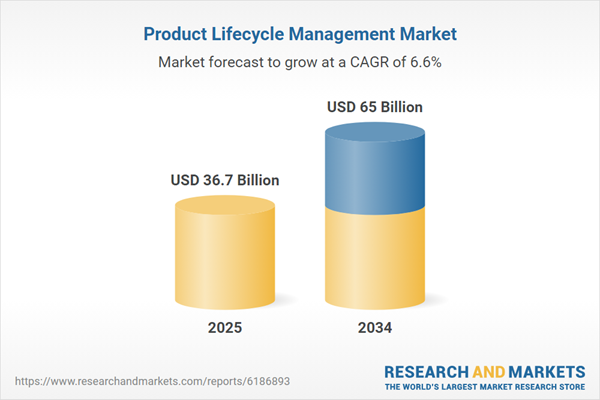Product Lifecycle Management Market Overview
The Product Lifecycle Management (PLM) market is undergoing significant growth as organizations across industries recognize the importance of streamlining product development, improving collaboration, and ensuring regulatory compliance. PLM solutions enable businesses to manage the entire product lifecycle from ideation to disposal, integrating various functions such as design, engineering, manufacturing, and supply chain management. With increasing complexity in product design, particularly in industries like automotive, aerospace, and electronics, companies are leveraging PLM systems to enhance operational efficiency and reduce time-to-market. The adoption of cloud-based PLM platforms is rising, providing businesses with scalable, cost-effective solutions that enhance data accessibility and real-time collaboration. Additionally, sustainability concerns and regulatory compliance are driving investments in PLM solutions that support eco-friendly product development and lifecycle assessments. As businesses continue their digital transformation journeys, PLM is becoming a strategic enabler for innovation, helping organizations stay ahead in an increasingly competitive landscape.The PLM market is witnessing a wave of technological advancements, with AI-powered automation, digital twin technology, and blockchain integration reshaping how companies manage product lifecycles. AI-driven analytics are enabling predictive maintenance, defect detection, and design optimization, reducing development costs and improving product reliability. Digital twins are allowing businesses to create virtual replicas of physical products, enabling real-time monitoring, simulations, and performance optimization. The shift to cloud-native PLM solutions continues to accelerate, as companies prioritize remote collaboration, streamlined workflows, and reduced IT infrastructure costs. Additionally, the role of blockchain in PLM is expanding, offering enhanced security, data traceability, and protection of intellectual property. Sustainability remains a key focus, with companies leveraging PLM tools to track carbon footprints, comply with environmental regulations, and integrate circular economy principles. The growing emphasis on smart manufacturing and Industry 4.0 is further driving demand for PLM solutions that integrate IoT, automation, and connected supply chain capabilities.
The PLM market is expected to undergo further evolution, driven by advancements in quantum computing, 6G connectivity, and AI-driven generative design. Quantum computing will enhance simulation capabilities, enabling businesses to develop complex product models with unprecedented accuracy. The adoption of AI-driven generative design will allow companies to create optimized, high-performance products based on real-time data insights. The convergence of PLM with IoT and edge computing will lead to fully interconnected product ecosystems, facilitating real-time decision-making and predictive maintenance. Augmented reality (AR) and virtual reality (VR) will become more prevalent in PLM applications, enabling immersive product design, digital prototyping, and virtual training. Sustainability initiatives will continue to shape the PLM landscape, with increased emphasis on circular economy strategies, product recycling, and eco-friendly materials. As digital transformation deepens, businesses will continue investing in next-generation PLM solutions that enhance innovation, efficiency, and market responsiveness.
Key Insights: Product Lifecycle Management Market
- AI-Driven Predictive Analytics: Companies are using AI-powered PLM systems to analyze product data, predict potential failures, and optimize design processes, reducing costs and improving efficiency.
- Expansion of Digital Twin Technology: Digital twins are enabling real-time monitoring and simulation of product performance, allowing businesses to optimize designs, minimize defects, and enhance operational efficiency.
- Blockchain for Secure Data Management: The integration of blockchain into PLM is improving data security, ensuring transparency in product development, and protecting intellectual property from counterfeiting and unauthorized access.
- Cloud-Based PLM Adoption: The shift to cloud-native PLM platforms is enhancing collaboration, improving data accessibility, and reducing IT infrastructure costs for organizations across industries.
- Integration of AR and VR in Product Development: Augmented and virtual reality technologies are being incorporated into PLM systems, enabling immersive design experiences, digital prototyping, and enhanced product visualization.
- Growing Demand for Smart Manufacturing: The rise of Industry 4.0 and connected production environments is driving the adoption of PLM solutions that integrate IoT, AI, and automation for improved efficiency.
- Regulatory Compliance and Sustainability Goals: Companies are investing in PLM solutions to meet regulatory requirements, track sustainability metrics, and ensure eco-friendly product development.
- Need for Faster Product Development Cycles: The increasing competition and demand for rapid innovation are pushing companies to adopt PLM solutions that streamline workflows and reduce time-to-market.
- Increased Focus on Data-Driven Decision-Making: AI-powered analytics and real-time data insights within PLM systems are enabling businesses to make informed decisions, improve product performance, and enhance resource allocation.
- High Implementation Costs and Complexity: The adoption of PLM solutions requires significant investment in infrastructure, training, and integration with existing systems, posing challenges for small and mid-sized enterprises.
Product Lifecycle Management Market Segmentation
By Component
- Software
- Services
By Deployment
- On-Premise
- On-Cloud
By End-User
- Automotive and Transportation
- Industrial Machinery
- Electronics and Semiconductors
- Retail
- Energy and Utilities
- Aerospace and Defense
- Pharmaceuticals
- IT and Telecomm
- Other End Users
Key Companies Analysed
- Oracle Corporation
- Siemens AG
- PTC Inc.
- Dassault Systèmes SE
- Autodesk
- Inc.
- ANSYS
- Inc.
- SAP SE
- Arena Solutions
- Infor
- Aras Corporation
- Odoo
- Jama Connect
- Anvyl
- PDXper
- OpenBOM
- Diota
- Masters of Pie
- Sopheon PLC
- Capgemini
- Accenturs
- Lectra SA
- Zaragoza Logistics Center
- IBM Corporation
- Amadeus
- Epicor Software Corporation
- Coupa Software
- Blue yonder
- Verizon connect
- JDA Software Group
- BluJay Solutions
- Inc.
- SPS Commerce Inc.
- E2open LLC
- Manhattan Associates
- Melcombe Partners
- Hewlett-Packard Company
- Deloitte Consulting and TCS
- IFS
- Arena
- Propel
- FusePLM
- Bamboo Rose
- Inflectra
- DXC Technology Co.
- Gerber Technology
- Centric Software
- Inc
- Biglever software
- Selerant Corporation
- Metalfor
- ISO Qualitas
- Indish Technologies
- Mckit Systems
- Product one.
Product Lifecycle Management Market Analytics
The report employs rigorous tools, including Porter’s Five Forces, value chain mapping, and scenario-based modeling, to assess supply-demand dynamics. Cross-sector influences from parent, derived, and substitute markets are evaluated to identify risks and opportunities. Trade and pricing analytics provide an up-to-date view of international flows, including leading exporters, importers, and regional price trends.Macroeconomic indicators, policy frameworks such as carbon pricing and energy security strategies, and evolving consumer behavior are considered in forecasting scenarios. Recent deal flows, partnerships, and technology innovations are incorporated to assess their impact on future market performance.
Product Lifecycle Management Market Competitive Intelligence
The competitive landscape is mapped through proprietary frameworks, profiling leading companies with details on business models, product portfolios, financial performance, and strategic initiatives. Key developments such as mergers & acquisitions, technology collaborations, investment inflows, and regional expansions are analyzed for their competitive impact. The report also identifies emerging players and innovative startups contributing to market disruption.Regional insights highlight the most promising investment destinations, regulatory landscapes, and evolving partnerships across energy and industrial corridors.
Countries Covered
- North America - Product Lifecycle Management market data and outlook to 2034
- United States
- Canada
- Mexico
- Europe - Product Lifecycle Management market data and outlook to 2034
- Germany
- United Kingdom
- France
- Italy
- Spain
- BeNeLux
- Russia
- Sweden
- Asia-Pacific - Product Lifecycle Management market data and outlook to 2034
- China
- Japan
- India
- South Korea
- Australia
- Indonesia
- Malaysia
- Vietnam
- Middle East and Africa - Product Lifecycle Management market data and outlook to 2034
- Saudi Arabia
- South Africa
- Iran
- UAE
- Egypt
- South and Central America - Product Lifecycle Management market data and outlook to 2034
- Brazil
- Argentina
- Chile
- Peru
Research Methodology
This study combines primary inputs from industry experts across the Product Lifecycle Management value chain with secondary data from associations, government publications, trade databases, and company disclosures. Proprietary modeling techniques, including data triangulation, statistical correlation, and scenario planning, are applied to deliver reliable market sizing and forecasting.Key Questions Addressed
- What is the current and forecast market size of the Product Lifecycle Management industry at global, regional, and country levels?
- Which types, applications, and technologies present the highest growth potential?
- How are supply chains adapting to geopolitical and economic shocks?
- What role do policy frameworks, trade flows, and sustainability targets play in shaping demand?
- Who are the leading players, and how are their strategies evolving in the face of global uncertainty?
- Which regional “hotspots” and customer segments will outpace the market, and what go-to-market and partnership models best support entry and expansion?
- Where are the most investable opportunities - across technology roadmaps, sustainability-linked innovation, and M&A - and what is the best segment to invest over the next 3-5 years?
Your Key Takeaways from the Product Lifecycle Management Market Report
- Global Product Lifecycle Management market size and growth projections (CAGR), 2024-2034
- Impact of Russia-Ukraine, Israel-Palestine, and Hamas conflicts on Product Lifecycle Management trade, costs, and supply chains
- Product Lifecycle Management market size, share, and outlook across 5 regions and 27 countries, 2023-2034
- Product Lifecycle Management market size, CAGR, and market share of key products, applications, and end-user verticals, 2023-2034
- Short- and long-term Product Lifecycle Management market trends, drivers, restraints, and opportunities
- Porter’s Five Forces analysis, technological developments, and Product Lifecycle Management supply chain analysis
- Product Lifecycle Management trade analysis, Product Lifecycle Management market price analysis, and Product Lifecycle Management supply/demand dynamics
- Profiles of 5 leading companies - overview, key strategies, financials, and products
- Latest Product Lifecycle Management market news and developments
Additional Support
With the purchase of this report, you will receive:- An updated PDF report and an MS Excel data workbook containing all market tables and figures for easy analysis.
- 7-day post-sale analyst support for clarifications and in-scope supplementary data, ensuring the deliverable aligns precisely with your requirements.
- Complimentary report update to incorporate the latest available data and the impact of recent market developments.
This product will be delivered within 1-3 business days.
Table of Contents
Companies Mentioned
- Oracle Corporation
- Siemens AG
- PTC Inc.
- Dassault Systèmes SE
- Autodesk Inc.
- ANSYS Inc.
- SAP SE
- Arena Solutions
- Infor
- Aras Corporation
- Odoo
- Jama Connect
- Anvyl
- PDXper
- OpenBOM
- Diota
- Masters of Pie
- Sopheon PLC
- Capgemini
- Accenturs
- Lectra SA
- Zaragoza Logistics Center
- IBM Corporation
- Amadeus
- Epicor Software Corporation
- Coupa Software
- Blue yonder
- Verizon connect
- JDA Software Group
- BluJay Solutions Inc.
- SPS Commerce Inc.
- E2open LLC
- Manhattan Associates
- Melcombe Partners
- Hewlett-Packard Company
- Deloitte Consulting and TCS
- IFS
- Arena
- Propel
- FusePLM
- Bamboo Rose
- Inflectra
- DXC Technology Co.
- Gerber Technology
- Centric Software Inc.
- Biglever software
- Selerant Corporation
- Metalfor
- ISO Qualitas
- Indish Technologies
- Mckit Systems
- Product one.
Table Information
| Report Attribute | Details |
|---|---|
| No. of Pages | 160 |
| Published | October 2025 |
| Forecast Period | 2025 - 2034 |
| Estimated Market Value ( USD | $ 36.7 Billion |
| Forecasted Market Value ( USD | $ 65 Billion |
| Compound Annual Growth Rate | 6.5% |
| Regions Covered | Global |
| No. of Companies Mentioned | 52 |









